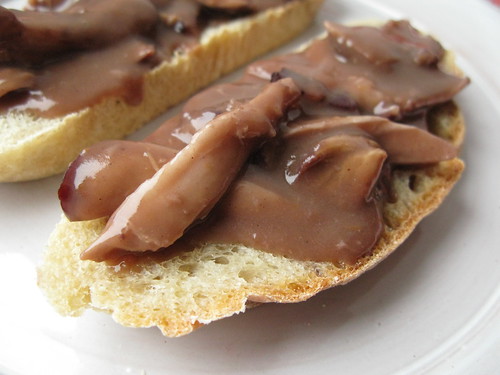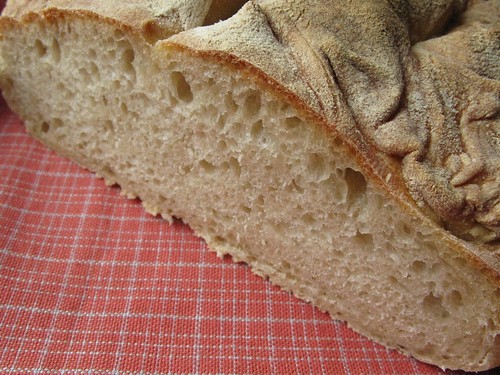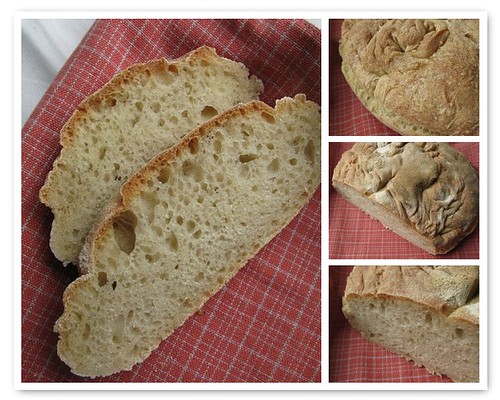Our Daring Bakers Host for December 2011 was Jessica of My Recipe Project and she showed us how fun it is to create Sour Dough bread in our own kitchens! She provided us with Sour Dough recipes from Bread Matters by AndrewWhitley as well as delicious recipes to use our Sour Dough bread in from Tonia George’s Things on Toast and Canteen’s Great British Food!
I have made sourgh dough bread before - but mine was made with rye flour (post in German).I liked the idea of making bread myself, especially after I watched a tv documentary about frozen-and-baked at the spot bread and breadrolls wich are used in lots of supermarkets and bakeries nowadays. The big bunch of enzymes used in those goods are not my kind of idea how to achieve good quality bread. So I gladly jumped in back to the roots and just the use of flour, water, salt and time.
There has been a book n my shelv for a while I wanted to bake all the recipes from the beginning to the end - The Bread Bakers Apprentice by Peter Reinhard. I made two ore three recipes but didn't manage to go further. Thanks to this challenge my 'bread sparkle' is back, because the French Country Bread I made was astonishing. I used a ceramic baking plate (last year's christmas present from a friend) which is suppode to produce a really good crust - and it worked! At first I was a little bit afraid because I had no proofing basket and the dough came out really flat onto that plate, but it got all right in the end.
The second task which came which the challenge was to 'showcase' the baked bread. A lot of ideas came into my mind, recipes I made before. There where French toasts (especially good for leftovers) or 'Arme Ritter' how we call them here. Or 'Strammer Max' which is basically bread covered in ham and fried egg, a popular cheap dish. I remember we eat lots of it during study time, using cheese and ketchup in addition. Old bread is always good for bread & butter pudding - don't throw it away! My favourite dish is 'Schweizer Brotauflauf' - Swiss bread pudding which is savoury. Here is a similar recipe from epicurious - Savory Bread Pudding with Asparagus, Gruyère, and Fines Herbes.
I wanted something special for my special bread, and I decided for my own version of a famous French dish - Coq au vin. I served the warm dish onto the (dry roasted) bread which made a great christmas meal.
French Country Bread
Servings: 1 large loaf plus extra wheat starter for further baking
Wheat Starter - Day 1:
- 4 1/2 tablespoons (70 ml) (40 gm/1 ½ oz) stoneground breadmaking whole-wheat or graham flour
- 3 tablespoons (45 ml) water
- Total scant ½ cup (115 ml) (3 oz/85 gm)
In a Tupperware or plastic container, mix the flour and water into a paste. Set the lid on top gently, cover with a plastic bag, to prevent messes in case it grows more than expected! Set somewhere warm (around 86 F if possible). I sometimes put mine on a windowsill near a radiator, but even if it’s not that warm, you’ll still get a starter going – it might just take longer.
Note: I learned from before you should not use plastic. Because I had success before with my normal (ceramic) bowl covered with a plate I used them.
Wheat Starter - Day 2:
Wheat Starter - Day 2:
- 4 1/2 tablespoons (70 ml) (40 gm/1 ½ oz) stoneground breadmaking whole-wheat or graham flour
- 3 tablespoons (45 ml) water
- scant 1/2 cup (115 ml) (3 oz/85 gm) starter from Day 1
- Total scant cup (230 ml) (6 oz/170 gm)
Stir the flour and water into the mixture from Day 1, cover, and return to its warm place.
Wheat Starter - Day 3:
Wheat Starter - Day 3:
- 4 1/2 tablespoons (70 ml) (40 gm/1 ½ oz) stoneground breadmaking whole-wheat or graham flour
- 4 teaspoons (20 ml) water
- scant 1 cup (230 ml) (6 oz/170 gm) starter from Day 2
- Total 1⅓ cup (320 ml) (230 gm/8-1/10 oz)
Wheat Starter - Day 4:
- 3/4 cup plus 1½ tablespoons (205 ml) (120 gm/4 ¼ oz) unbleached all-purpose flour
- 1/2 cup less 4 teaspoons (100 ml) water
- 1⅓ cup (320 ml) (230 gm/8 oz) starter from Day 3
- Total scant 2⅔ cup (625 ml) (440 gm/15½ oz)
Stir the flour and water into the mixture from Day 3, cover, and return to its warm place. At this point it should be bubbling and smell yeasty. If not, repeat this process for a further day or so until it is!
French Country Bread - Stage 1: Refreshing the leaven
- 1 cup less 1 tablespoon (225 ml) (160 gm/5 ⅔ oz) wheat Leaven Starter
- 6 tablespoons less 1 teaspoon (85 ml) (50 gm/1¾ oz) stoneground bread making whole-wheat or graham flour
- 1 cup plus 2 teaspoons (250 ml) (150 gm/5 ⅓ oz) unbleached all purpose flour
- 1/2 cup (120 ml) water
- Production Leaven Total 2¾ cups plus 4 teaspoons (680 ml) (480 gm /1 lb 1 oz)
Mix everything into a sloppy dough. It may be fairly stiff at this stage. Cover and set aside for 4 hours, until bubbling and expanded slightly.
French Country Bread - Stage 2: Making the final dough
- 3/4 cup less 1 teaspoon (175 ml) (100 gm/3 ½ oz) stoneground breadmaking whole-wheat or graham flour, plus more for dusting
- 2 cups plus 2 tablespoons (510 ml) (300gm/10 ½ oz) unbleached all-purpose flour
- 1¼ teaspoons (7½ ml) (7 gm/¼ oz) sea salt or ⅔ teaspoon (3⅓ ml) (3 gm/⅛ oz) table salt
- 1 ¼ cups (300 ml) water
- 1 ¾ cups (425 ml) (300 gm/10 ½ oz) production leaven – this should leave some (1 cup) for your next loaf.
- Total 6 cups less 2 tablespoons 1415 ml (1007 gm/35 ½ oz/2 lb 3½ oz)
Mix the dough with all the ingredients except the production leaven. It will be a soft dough. Knead on an UNFLOURED surface for about 8-10 minutes, getting the tips of your fingers wet if you need to. You can use dough scrapers to stretch and fold the dough at this stage, or air knead if you prefer. Basically, you want to stretch the dough and fold it over itself repeatedly until you have a smoother, more elastic dough.
Smooth your dough into a circle, then scoop your production leaven into the centre. You want to fold the edges of the dough up to incorporate the leaven, but this might be a messy process. Knead for a couple minutes until the leaven is fully incorporated in the dough.
Smooth your dough into a circle, then scoop your production leaven into the centre. You want to fold the edges of the dough up to incorporate the leaven, but this might be a messy process. Knead for a couple minutes until the leaven is fully incorporated in the dough.
Spread some water on a clean bit of your work surface and lay the dough on top. Cover with an upturned bowl, lining the rim of the bowl with a bit of water. Leave for an hour, so that the gluten can develop and the yeasts can begin to aerate the dough.
Once your dough has rested, you can begin to stretch and fold it. Using wet hands and a dough scraper, stretch the dough away from you as far as you can without breaking it and fold it back in on itself. Repeat this in each direction, to the right, towards you, and to the left. This will help create a more ‘vertical’ dough, ready for proofing. Video demonstration here.
Heavily flour a banneton/proofing basket with whole wheat flour and rest your dough, seam side up, in the basket. Put the basket in a large plastic bag, inflate it, and seal it. Set aside somewhere warm for 3-5 hours, or until it has expanded a fair bit. It is ready to bake when the dough responds to a gently poke by slowly pressing back to shape.
Preheat the oven to hot 425°F/220°C/gas mark 7. Line a baking sheet with parchment, then carefully invert the dough onto the sheet. I like to put the baking sheet on top of the basket, then gently flip it over so as to disturb the dough as little as possible. Make 2-3 cuts on top of the loaf and bake for 40-50 minutes, reducing the temperature to moderately hot 400°F/200°C/gas mark 6 after 10 minutes. Cool on a cooling rack.
Notes: I usually knead my doughs into my large IKEA plastic bowl because I have a small working surface wich really fast gets messy during baking. I don't own a proofing basket either - so I put the dough onto a floured (linen) kitchen towel into the the IKEA bowl, covered it with cling film and put it into a large plastic bag.
Notes: I usually knead my doughs into my large IKEA plastic bowl because I have a small working surface wich really fast gets messy during baking. I don't own a proofing basket either - so I put the dough onto a floured (linen) kitchen towel into the the IKEA bowl, covered it with cling film and put it into a large plastic bag.
Coq au vin toasts
serves four
serves four
- half of my recipe for Coq et lapin au vin, slightly cooled
- 8 large slices of a French country bread
For a deluxe version, you can fry the bread into some butter, rub them with fresh garlic and sprinkle chopped parsley on top.







1 Kommentar:
Your bread looks absolutely perfect, inside and out!
Kommentar veröffentlichen